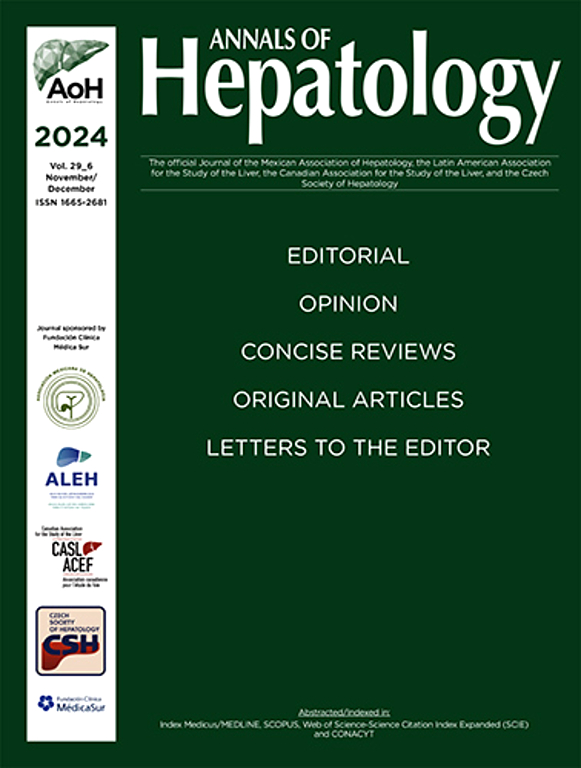Prevalence and evaluation of sleep disturbances in Mexican patients with hepatic cirrhosis through the application of the Pittsburgh sleep questionnaire
IF 3.7
3区 医学
Q2 GASTROENTEROLOGY & HEPATOLOGY
引用次数: 0
Abstract
Introduction and Objectives
According to the literature, patients with cirrhosis have a high prevalence of sleep disturbances, which increase as the disease progresses. There are few studies conducted in this patient group, with a small number of samples, reflecting alterations in sleep quality and rest. The Pittsburgh Sleep Quality Index (PSQI) is a tool that allows us to evaluate sleep quality and the level of disturbances it may present. To assess the type and prevalence of sleep disturbances in a Mexican group of patients with cirrhosis through the application of the Pittsburgh questionnaire.
Materials and Patients
A prospective, cross-sectional, and epidemiological study was conducted with 300 individuals, of whom 266 did not have hepatic diseases and 74 were diagnosed with cirrhosis.
The Pittsburgh questionnaire was administered to them, which consists of 7 components that generate a total score. Total scores were interpreted as follows: 1-4 without sleep disturbances, 5-7 with mild disturbance, 8-14 with moderate disturbance, and 15 or more indicating severe disturbance.
Results were compared using Odds Ratio (OR) to assess the effect.
Results
Of the individuals evaluated, 74 (24.66%) were diagnosed with cirrhosis, with 42 women (56%) and 32 men (43.24%). The remaining 226 participants (75.33%) did not have liver diseases, with 150 women (66.3%) and 75 men (33.1%). When comparing the total scores, it was observed that 57 people without sleep disturbances, 18 (31.57%) were in the cirrhosis group, while 39 (68.42%) were not. Additionally, of the 102 individuals with mild alterations, 20 (19.60%) were in the cirrhosis group and 82 (80.39%) were not. Of the 131 individuals with moderate alterations, 32 (24.42%) had cirrhosis and 99 (75.57%) did not. Finally, of the 10 individuals with severe alterations, 4 (40%) had cirrhosis and 6 (60%) did not. The calculation of the Odds Ratio was 1.09, indicating that patients with cirrhosis had a similar risk of sleep disturbances as those without cirrhosis.
Conclusions
In our study, it seems to demonstrate that contrary to previous reports in the literature, no difference was found in the prevalence of sleep disturbances between our population without cirrhosis and patients with cirrhosis.
This study is the first to apply this validated and translated questionnaire in Spanish to a Mexican population of patients with cirrhosis and healthy individuals to evaluate their sleep quality and the first to have a significant sample.
应用匹兹堡睡眠问卷调查墨西哥肝硬化患者睡眠障碍的患病率和评估
文献资料显示,肝硬化患者普遍存在睡眠障碍,且睡眠障碍随病情进展而增加。该患者组的研究较少,样本较少,反映了睡眠质量和休息的变化。匹兹堡睡眠质量指数(PSQI)是一种工具,可以让我们评估睡眠质量及其可能出现的干扰程度。通过匹兹堡问卷的应用,评估墨西哥肝硬化患者睡眠障碍的类型和患病率。材料和患者对300人进行了一项前瞻性、横断面和流行病学研究,其中266人没有肝病,74人被诊断为肝硬化。对他们进行匹兹堡问卷调查,该问卷由7个组成部分组成,并产生总分。总分解释如下:1-4分无睡眠障碍,5-7分为轻度障碍,8-14分为中度障碍,15分及以上为严重障碍。使用优势比(OR)对结果进行比较,以评估效果。结果74人(24.66%)被诊断为肝硬化,其中女性42人(56%),男性32人(43.24%)。其余226名参与者(75.33%)没有肝脏疾病,其中150名女性(66.3%)和75名男性(33.1%)。比较总分,无睡眠障碍者57人,肝硬化组18人(31.57%),无睡眠障碍者39人(68.42%)。此外,102例轻度改变的患者中,肝硬化组20例(19.60%),非肝硬化组82例(80.39%)。在131例中度改变患者中,32例(24.42%)有肝硬化,99例(75.57%)无肝硬化。最后,在10个有严重改变的个体中,4个(40%)有肝硬化,6个(60%)没有。计算出的优势比为1.09,表明肝硬化患者与非肝硬化患者存在相似的睡眠障碍风险。结论:在我们的研究中,似乎证明了与先前文献报道相反的是,在我们的无肝硬化人群和肝硬化患者之间没有发现睡眠障碍的患病率差异。本研究首次将这一经过验证和翻译的西班牙语调查问卷应用于墨西哥肝硬化患者和健康个体,以评估他们的睡眠质量,也是第一个具有重要意义的样本。
本文章由计算机程序翻译,如有差异,请以英文原文为准。
求助全文
约1分钟内获得全文
求助全文
来源期刊

Annals of hepatology
医学-胃肠肝病学
CiteScore
7.90
自引率
2.60%
发文量
183
审稿时长
4-8 weeks
期刊介绍:
Annals of Hepatology publishes original research on the biology and diseases of the liver in both humans and experimental models. Contributions may be submitted as regular articles. The journal also publishes concise reviews of both basic and clinical topics.
 求助内容:
求助内容: 应助结果提醒方式:
应助结果提醒方式:


